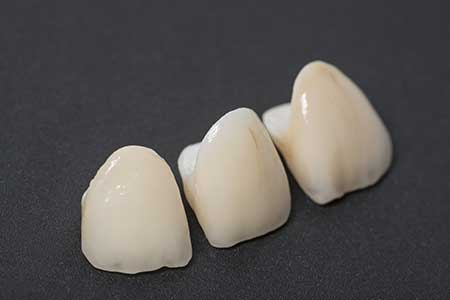Since the introduction of porcelain-fused-to-metal (PFM) crowns in the 1960s, the dental industry has sought materials with both the esthetic value of porcelain, and the strength of noble metals to withstand the pressure of posterior occlusal forces.
Glass-ceramic materials that came along in the 1980s were confined to use on anterior teeth. In the early 2000s, researchers found that a toughened version of the metal zirconia met the strength requirements needed for posterior teeth, although the esthetics of the material left much to be desired.
Today, with improved technology, zirconia now rivals PFMs and all-ceramic restorations both for strength and beauty.
A member of the titanium family of metals, zirconia has multi-industry uses and is ideal for use in both anterior and posterior crowns where it fulfills functional requirements and can be custom shaded for quality esthetics.
Advantages
Zirconia is now the preferred material for crown and bridge fabrication, including implant-supported restorations. These are replacing metal-based restoration as the choice of most dentists, lab technicians, and patients. Because it can withstand occlusal forces without causing wear on opposing teeth, the material has quickly replaced full-metal and PFM’s as the material of choice.
Zirconia is more wear resistant than gold, retaining its shape and resisting the tendency to crack and erode by patients who brux. The flex strength value (MPa) of zirconia is more than twice that of traditional lithium disilicate (glass-ceramic) making it the ideal material for posterior crowns and bridges.
Recent Article: Benefits of Digitally Planned Implant Placement
While there is, as always with innovative technology, a learning curve for dentists new to working with zirconia, the techniques for tooth preparations is basically the same as for porcelain and glass ceramic materials. A more conservative preparation of the patient’s original tooth structure is a distinct advantage.
With zirconia, clearance may be as little as 1 mm, while lithium disilicate materials require 1.5 to 2mm and will not be as strong. A thicker chamfer is preferable to a feathered margin to provide for minimum thickness at the margin while retaining the ability to taper it to the prep.
Traditional impressions or digital impressions can be used with equal success.
Concerns
As with all new materials and technology, zirconia does have its drawbacks.
Many dentists are hesitant to use zirconia because there are fewer long-term research studies to assess its properties and compare the longevity of the material to gold, porcelain, and lithium disilicate. However, the studies completed thus far all reflect positively on the future of zirconia crowns.
There is also a lack of ability to bond the material to the preps. Though, that might be seen as an advantage by some, since only cement is needed to permanently seat the restoration. The hardness, while certainly considered one of zirconia’s advantages, might be a disadvantage when having to remove or access through them for endodontic treatment.
Recent Article: Why You Should Go Digital With IOS Dentistry
Chairside adjustments, while usually minimal, must be made safely, using diamond burs at slow speed with copious amounts of water, polishing wheels, and cones specifically designed for use with zirconia.
Do not use carbide burs or diamonds at high-speed for adjustments due to microscopic fractures that can occur from the impact of the burs on the material.
Ready to Try?
The future of zirconia use in dentistry is unlimited.
Gold and other noble metals used for decades are slowly dying out due to not only prohibitive cost, but also lack of demand by consumers. Zirconia more than fills that gap.
Researchers continually improve the translucency of these restorations, making them legitimate rivals to all-ceramic for beauty and surpassing other dental materials for strength and durability.
Here are First Choice Dental Lab, we specialize in all types of zirconia restorations, including full-contour and esthetic anterior.
Ship us your case today by clicking HERE, or send digital scans HERE to give zirconia restorations a try!
Want to learn more? Complete the form below and let us help you plan your next restoration!
Sources:
https://bayshoredentalstudio.com/choosing-between-lithium-disilicate-zirconia/
https://www.dentaleconomics.com/science-tech/article/16390419/zirconia-vs-lithium-disilicate
https://www.ncbi.nlm.nih.gov/pmc/articles/PMC3723107/
https://www.ncbi.nlm.nih.gov/pmc/articles/PMC4026739/
https://schackdental.com/emax-vs-zirconia/
https://www.sciencedirect.com/science/article/abs/pii/S0022391307600456
https://www.sciencedirect.com/science/article/pii/B9781782422792000123
Jolly, Robert, D.D.S., DIY Dental Lab owner/manager. Personal interview. 25 September 2019.




